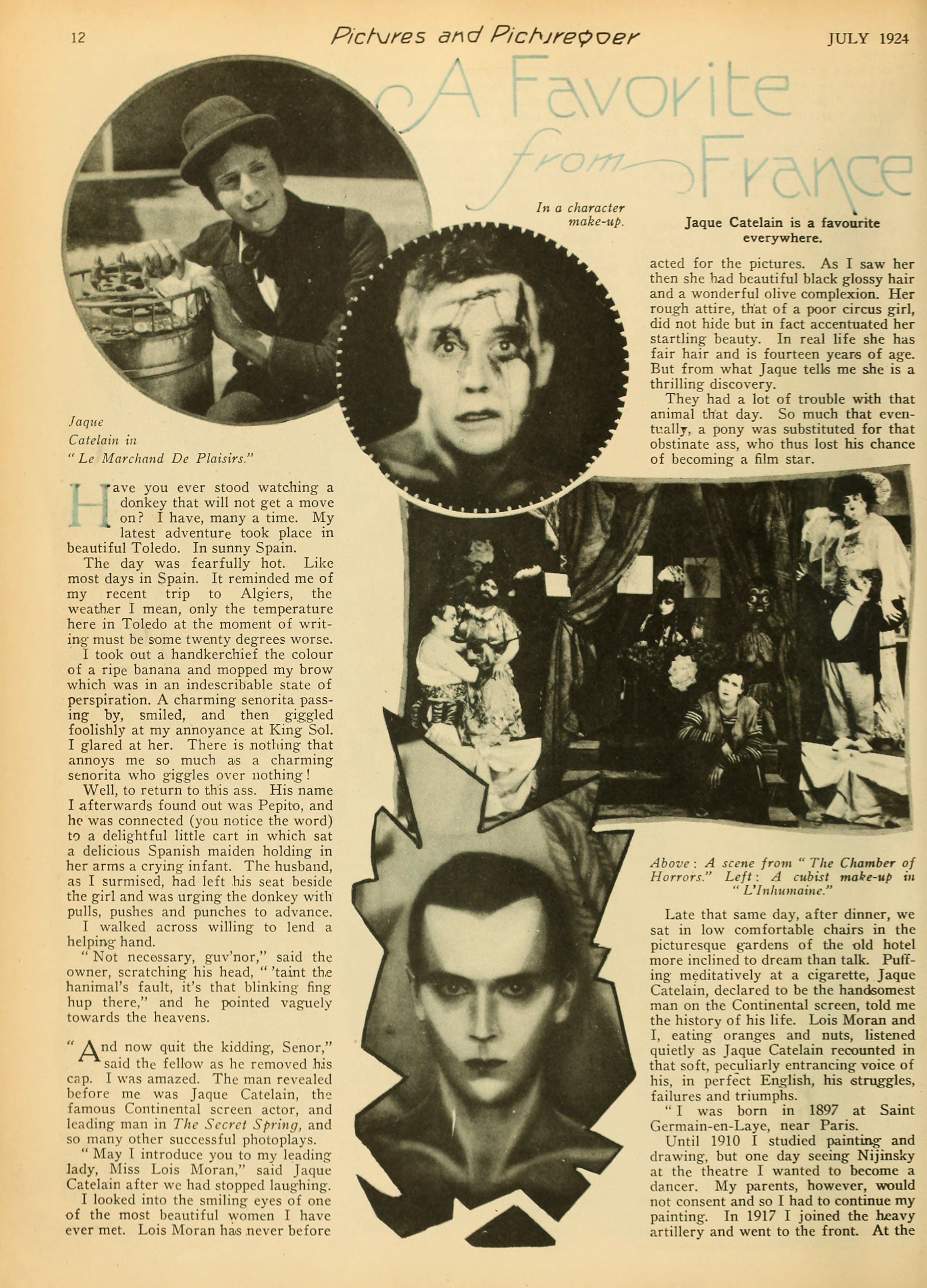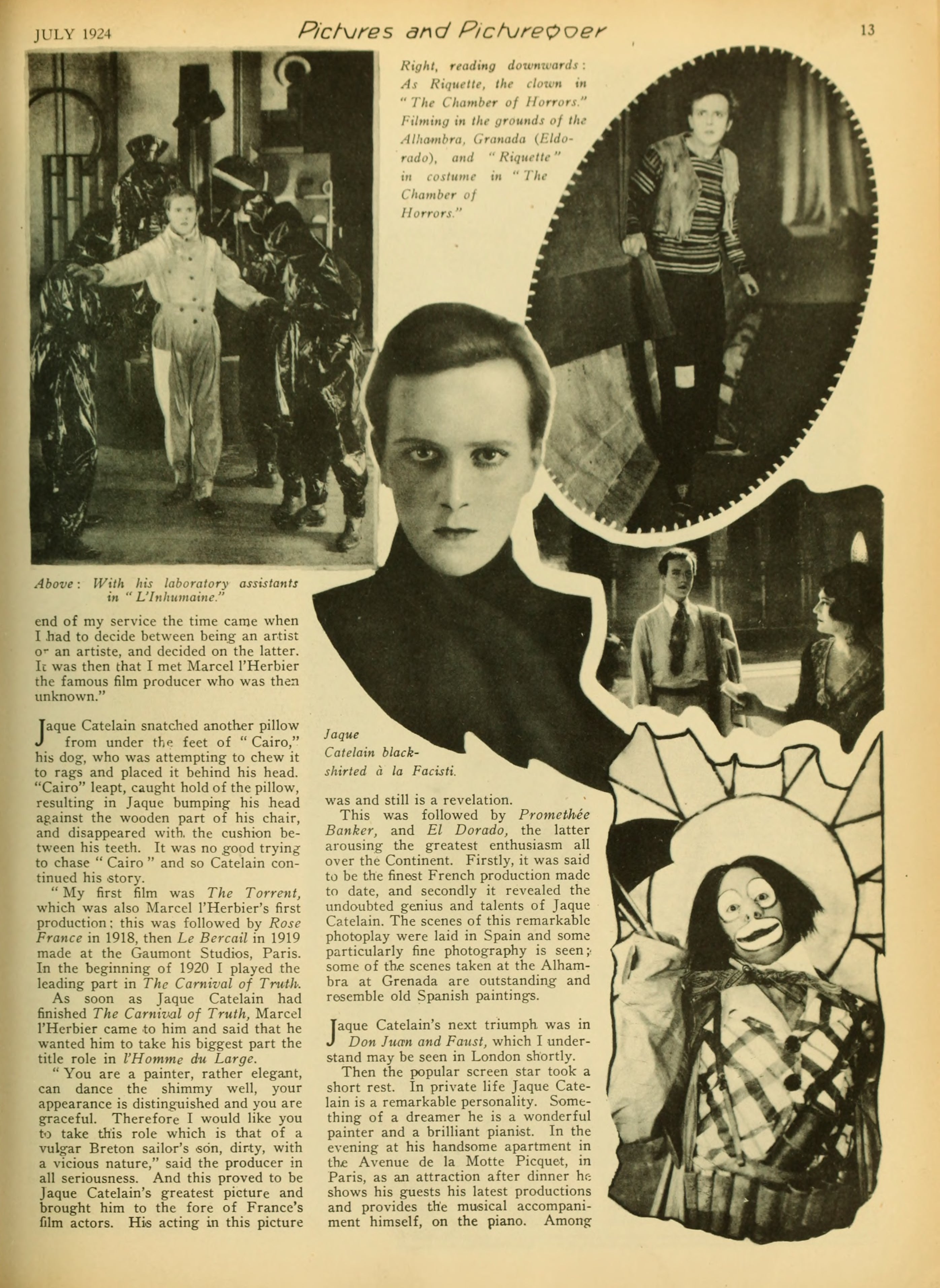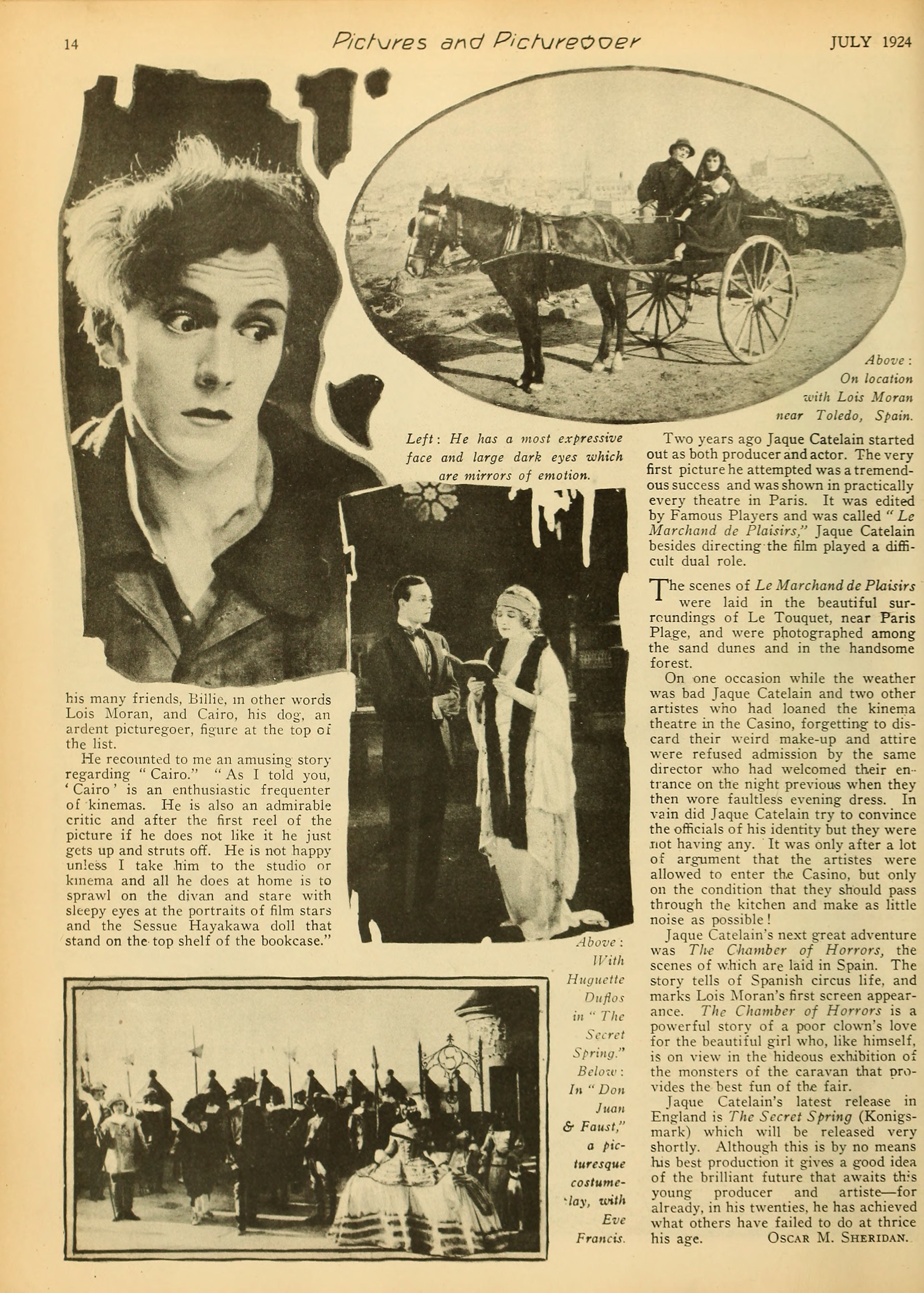Jaque Catelain — A Favourite from France (1924) 🇬🇧

Have you ever stood watching a donkey that will not get a move on? I have, many a time. My latest adventure took place in beautiful Toledo. In sunny Spain.
by Oscar M. Sheridan
The day was fearfully hot. Like most days in Spain. It reminded me of my recent trip to Algiers, the weather I mean, only the temperature here in Toledo at the moment of writing must be some twenty degrees worse.
I took out a handkerchief the colour of a ripe banana and mopped my brow which was in an indescribable state of perspiration. A charming senorita passing by, smiled, and then giggled foolishly at my annoyance at King Sol. I glared at her. There is nothing that annoys me so much as a charming senorita who giggles over nothing!
Well, to return to this ass. His name I afterwards found out was Pepito, and he was connected (you notice the word) to a delightful little cart in which sat a delicious Spanish maiden holding in her arms a crying infant. The husband, as I surmised, had left his seat beside the girl and was urging the donkey with pulls, pushes and punches to advance.
I walked across willing to lend a helping hand.
“Not necessary, guv’nor,” said the owner, scratching his head, “’taint the hanimal’s fault, it’s that blinking fing hup there,” and he pointed vaguely towards the heavens.
“And now quit the kidding, Senor,” said the fellow as he removed his cap. I was amazed. The man revealed before me was Jaque Catelain, the famous Continental screen actor, and leading man in The Secret Spring, and so many other successful photoplays.
“May I introduce you to my leading lady, Miss Lois Moran,” said Jaque Catelain after we had stopped laughing.
I looked into the smiling eyes of one of the most beautiful women I have ever met. Lois Moran has never before acted for the pictures. As I saw her then she had beautiful black glossy hair and a wonderful olive complexion. Her rough attire, that of a poor circus girl, did not hide but in fact accentuated her startling beauty. In real life she has fair hair and is fourteen years of age. But from what Jaque tells me she is a thrilling discovery.
They had a lot of trouble with that animal that day. So much that eventually, a pony was substituted for that obstinate ass, who thus lost his chance of becoming a film star.
Late that same day, after dinner, we sat in low comfortable chairs in the picturesque gardens of the old hotel more inclined to dream than talk. Puffing meditatively at a cigarette, Jaque Catelain, declared to be the handsomest man on the Continental screen, told me the history of his life. Lois Moran and I, eating oranges and nuts, listened quietly as Jaque Catelain recounted in that soft, peculiarly entrancing voice of his, in perfect English, his struggles, failures and triumphs.
“I was born in 1897 at Saint Germain-en-Laye, near Paris.
Until 1910 I studied painting and drawing, but one day seeing Nijinsky at the theatre I wanted to become a dancer. My parents, however, would not consent and so I had to continue my painting. In 1917 I joined the heavy artillery and went to the front. At the end of my service the time came when I had to decide between being an artist or an artiste, and decided on the latter. It was then that I met Marcel l’Herbier the famous film producer who was then unknown.”
Jaque Catelain snatched another pillow from under the feet of Cairo, his dog, who was attempting to chew it to rags and placed it behind his head. Cairo leapt, caught hold of the pillow, resulting in Jaque bumping his head against the wooden part of his chair, and disappeared with, the cushion between his teeth. It was no good trying to chase Cairo and so Catelain continued his story.
“My first film was ‘The Torrent,’ which was also Marcel l’Herbier’s first production; this was followed by ‘Rose France’ in 1918, then ‘Le Bercail’ in 1919 made at the Gaumont Studios, Paris. In the beginning of 1920 I played the leading part in ‘The Carnival of Truth.’
As soon as Jaque Catelain had finished The Carnival of Truth, Marcel l’Herbier came to him and said that he wanted him to take his biggest part the title role in “L’Homme du Large.”
“You are a painter, rather elegant, can dance the shimmy well, your appearance is distinguished and you are graceful. Therefore I would like you to take this role which is that of a vulgar Breton sailor’s son, dirty, with a vicious nature,” said the producer in all seriousness. And this proved to be Jaque Catelain’s greatest picture and brought him to the fore of France’s film actors. His acting in this picture was and still is a revelation.
This was followed by “Promethée Banker,” and “El Dorado,” the latter arousing the greatest enthusiasm all over the Continent. Firstly, it was said to be the finest French production made to date, and secondly it revealed the undoubted genius and talents of Jaque Catelain. The scenes of this remarkable photoplay were laid in Spain and some particularly fine photography is seen; some of the scenes taken at the Alhambra at Grenada are outstanding and resemble old Spanish paintings.
Jaque Catelain’s next triumph was in “Don Juan” and “Faust,” which I understand may be seen in London shortly.
Then the popular screen star took a short rest. In private life Jaque Catelain is a remarkable personality. Something of a dreamer he is a wonderful painter and a brilliant pianist. In the evening at his handsome apartment in the Avenue de la Motte Picquet, in Paris, as an attraction after dinner he shows his guests his latest productions and provides the musical accompaniment himself, on the piano. Among his many friends, Billie, in other words Lois Moran, and Cairo, his dog, an ardent picturegoer, figure at the top of the list.
He recounted to me an amusing story regarding Cairo. “As I told you, Cairo is an enthusiastic frequenter of kinemas. He is also an admirable critic and after the first reel of the picture if he does not like it he just gets up and struts off. He is not happy unless I take him to the studio or kinema and all he does at home is to sprawl on the divan and stare with sleepy eyes at the portraits of film stars and the Sessue Hayakawa doll that stand on the top shelf of the bookcase.”
Two years ago Jaque Catelain started out as both producer and actor. The very first picture he attempted was a tremendous success and was shown in practically every theatre in Paris. It was edited by Famous Players and was called “Le Marchand de Plaisirs,” Jaque Catelain besides directing the film played a difficult dual role.
The scenes of Le Marchand de Plaisirs were laid in the beautiful surroundings of Le Touquet, near Paris Plage, and were photographed among the sand dunes and in the handsome forest.
On one occasion while the weather was bad Jaque Catelain and two other artistes who had loaned the kinema theatre in the Casino, forgetting to discard their weird make-up and attire were refused admission by the same director who had welcomed their entrance on the night previous when they then wore faultless evening dress. In vain did Jaque Catelain try to convince the officials of his identity but they were not having any. It was only after a lot of argument that the artistes were allowed to enter the Casino, but only on the condition that they should pass through the kitchen and make as little noise as possible!
Jaque Catelain’s next great adventure was “The Chamber of Horrors,” the scenes of which are laid in Spain. The story tells of Spanish circus life, and marks Lois Moran’s first screen appearance. The Chamber of Horrors is a powerful story of a poor clown’s love for the beautiful girl who, like himself, is on view in the hideous exhibition of the monsters of the caravan that provides the best fun of the fair.
Jaque Catelain’s latest release in England is The Secret Spring (Konigsmark) which will be released very shortly. Although this is by no means his best production it gives a good idea of the brilliant future that awaits this young producer and artiste — for already, in his twenties, he has achieved what others have failed to do at thrice his age.

Above: A scene from The Chamber of Horrors.
Left: A cubist make-up in “L’lnhumaine.”
Jaque Catelain in “Le Marchand De Plaisirs.”
In a character make-up.

Right, reading downwards: As Riquette, the clown in The Chamber of Horrors. Filming in the grounds of the Alhambra, Granada (El Dorado), and Riquette in costume in The Chamber of Horrors.
Above: With his laboratory assistants in “L’lnhumaine.”
Jaque Catelain black-shirted a la Facisti.

Above: With Huguette Duflos in The Secret Spring.
Below: In “Don Juan and “Faust,” a picturesque costume-play, with Eve Francis.
Above: On location with Lois Moran near Toledo, Spain.
Collection: Picturegoer Magazine, July 1924
